详细教程:用Unsloth快速微调OpenAI首个开源大模型gpt-oss!低配显卡也能拥有专属GPT
分享我的Colab文件:
https://colab.research.google.com/drive/11jEpOECqYKEWh_75Bc3hSw2CmWqE4oF3?usp=sharing
点开链接会进入Colab界面,在这所做的修改不会保存,需要将它复制保存到Drive中。
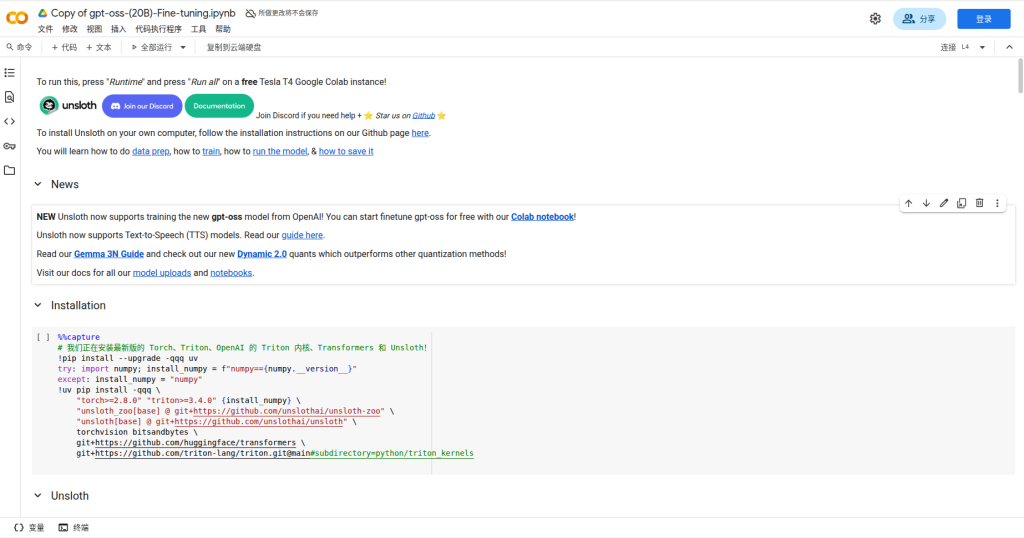

上传文件

在这个单元格data_files=填入你的数据集名称;如果是别的数据集格式需要修改代码

修改微调细节:

最后一个单元格是测试微调效果,在原项目上是没有的,如果不需要可以直接删除:

如果使用T4 GPU会有概率超出可使用显存,导致失败;推荐选择L4 GPU性价比最高;A100 GPU速度更快,收费更高,具体看你需求。

点击Restart session and run all即可一键运行:

时序知识图谱测试解析
创建虚拟环境: python -m venv tkg_agent_env
激活虚拟环境: source tkg_agent_env/bin/activate
克隆代码库 git clone https://github.com/openai/openai-cookbook.git

进入项目目录: cd openai-cookbook/examples/partners/temporal_agents_with_knowledge_graphs/
安装Jupyter Lab: pip install jupyterlab
启动Jupyter Lab服务: jupyter lab

作用: 本地启动Web服务器,在浏览器打开Jupyter Lab操作界面,与项目文件进行交互。

双击打开temporal_agents_with_konwledge_graphs.ipynb文件

点击“双箭头”图标,重启内核并一键运行所有单元格
等待输出结果

需要OpenAI的API key调用模型分块、问答
分块时如遇到API速率上限可选择更换模型,需自己手动添加

后续没有问题就会生成图谱

可在单元格修改问题测试问答

在作者Huggingface上也有上传的已经处理好的数据集,代码可以直接下载调用
关于过程步骤,整个文件有详细的英文说明。
DataGraphX怎么帮企业从‘信息堆’迈向‘智能洞察’?
数据是新时代的石油,但未经提炼的原油毫无价值。今天,几乎所有企业都坐拥海量数据,却发现自己被困在了一座巨大的“信息堆”中——数据彼此割裂,难以查询,无法形成有效的洞察力来指导决策。
如何才能让数据开口说话,甚至能听懂我们的问题并给出智慧的答案?答案是知识图谱。它能将杂乱的数据连接成一张智能网络,让每一次查询都成为一次深度洞察的开始。
DataGraphX 正是为此而生的利器。它不仅仅是一个工具,更是一套帮助企业从“信息堆”迈向“智能洞察”的完整方法论和技术引擎。接下来,我们将探讨DataGraphX如何赋能企业,将数据资产转化为真正的决策优势。
Mineru的api调用
import requests
import time
import os
class PDFProcessor:
def __init__(self, token):
self.token = token
self.headers = {
'Authorization': f'Bearer {token}'
}
def upload_file(self, file_path):
"""上传本地文件到临时存储"""
print(f"📤 正在上传文件: {os.path.basename(file_path)}")
# 使用 tmpfiles.org
try:
with open(file_path, 'rb') as f:
response = requests.post(
'https://tmpfiles.org/api/v1/upload',
files={'file': f}
)
if response.status_code == 200:
result = response.json()
# 获取直接下载链接
url = result['data']['url']
direct_url = url.replace('tmpfiles.org/', 'tmpfiles.org/dl/')
print(f"✅ 上传成功: {direct_url}")
return direct_url
except Exception as e:
print(f"❌ 上传失败: {e}")
return None
def process_pdf(self, file_path):
"""处理本地PDF文件"""
# 1. 上传文件
pdf_url = self.upload_file(file_path)
if not pdf_url:
return None
# 2. 创建MinerU任务
print("📄 创建解析任务...")
task_url = 'https://mineru.net/api/v4/extract/task'
headers = {
'Content-Type': 'application/json',
'Authorization': f'Bearer {self.token}'
}
data = {
'url': pdf_url,
'is_ocr': True,
'enable_formula': True,
'enable_table': True,
'language': 'auto' # 中文文档
}
response = requests.post(task_url, headers=headers, json=data)
result = response.json()
if result['code'] != 0:
print(f"❌ 创建任务失败: {result['msg']}")
return None
task_id = result['data']['task_id']
print(f"✅ 任务ID: {task_id}")
# 3. 等待处理完成
print("⏳ 等待处理...")
while True:
time.sleep(5)
status_url = f'https://mineru.net/api/v4/extract/task/{task_id}'
status_response = requests.get(status_url, headers=headers)
status_data = status_response.json()
state = status_data['data']['state']
if state == 'done':
zip_url = status_data['data']['full_zip_url']
print(f"✅ 处理完成!")
print(f"📦 下载地址: {zip_url}")
# 下载结果
self.download_result(zip_url, task_id)
return status_data
elif state == 'failed':
print(f"❌ 处理失败: {status_data['data']['err_msg']}")
return None
elif state == 'running':
progress = status_data['data'].get('extract_progress', {})
extracted = progress.get('extracted_pages', 0)
total = progress.get('total_pages', 0)
print(f"⏳ 正在处理... {extracted}/{total} 页")
else:
print(f"📊 状态: {state}")
def download_result(self, zip_url, task_id):
"""下载结果文件"""
save_path = f"mineru_result_{task_id}.zip"
try:
response = requests.get(zip_url, stream=True)
with open(save_path, 'wb') as f:
for chunk in response.iter_content(chunk_size=8192):
f.write(chunk)
print(f"✅ 结果已保存到: {save_path}")
except Exception as e:
print(f"❌ 下载失败: {e}")
# 使用您的Token和文件
TOKEN = "eyJ0eXBlIjoiSldUIiwiYWxnIjoiSFM1MTIifQ.eyJqdGkiOiIyOTkwMzQ1NiIsInJvbCI6IlJPTEVfUkVHSVNURVIiLCJpc3MiOiJPcGVuWExhYiIsImlhdCI6MTc1MTM3NDYyOCwiY2xpZW50SWQiOiJsa3pkeDU3bnZ5MjJqa3BxOXgydyIsInBob25lIjoiMTg5NTIxNTUyNTAiLCJvcGVuSWQiOm51bGwsInV1aWQiOiI1YTA0YmUxMC1kMTJkLTQ3NzktYjYyYi1mM2U4NTRmZWI0YTQiLCJlbWFpbCI6IiIsImV4cCI6MTc1MjU4NDIyOH0.kKzBBW2Jp2sVh3HXRVRlz-Df8WMHcDB7PM1pZbrmn3_QEt39bw3OrNAf8OkrmgY9Kign1fpTxPRzxopOenqO7Q"
# 处理您的PDF文件
processor = PDFProcessor(TOKEN)
local_pdf = "/home/wang/1_time/00bjfei/宁德时代宁德时代新能源科技股份有限公司2024年半年度报告174页(1).pdf"
# 检查文件是否存在
if os.path.exists(local_pdf):
processor.process_pdf(local_pdf)
else:
print(f"❌ 文件不存在: {local_pdf}")FastAPI-MCP
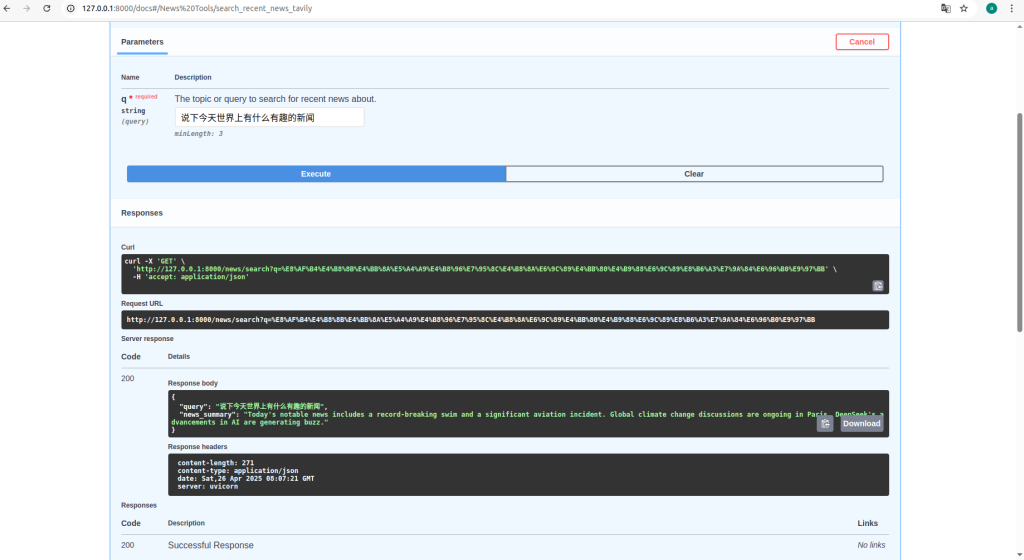
微信:adoresever
我的开源项目:
https://github.com/adoresever/DataGraphX_Learn
https://github.com/adoresever/Pretuning
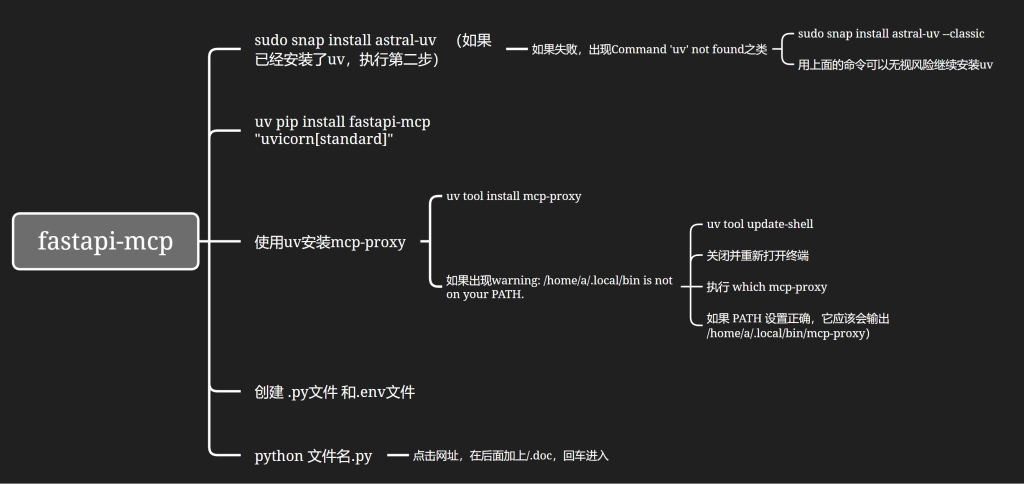
- fastapi-mcp安装部署
- sudo snap install astral-uv (如果已经安装了uv,执行第二步)
- 如果失败,出现Command ‘uv’ not found之类
- sudo snap install astral-uv –classic
- 用上面的命令可以无视风险继续安装uv
- 如果失败,出现Command ‘uv’ not found之类
- uv pip install fastapi-mcp “uvicorn[standard]”
- 使用uv安装mcp-proxy
- uv tool install mcp-proxy
- 如果出现warning: /home/a/.local/bin is not on your PATH.
- uv tool update-shell
- 关闭并重新打开终端
- 执行 which mcp-proxy
- 如果 PATH 设置正确,它应该会输出 /home/a/.local/bin/mcp-proxy)
- 创建 .py文件 和.env文件
- python 文件名.py
- 点击网址,在后面加上/.doc,回车进入
- sudo snap install astral-uv (如果已经安装了uv,执行第二步)
代码
import os
import httpx
from fastapi import FastAPI, HTTPException, Query
from fastapi_mcp import FastApiMCP
from pydantic import BaseModel, Field
from dotenv import load_dotenv
import logging
import json
# --- 配置与设置 ---
load_dotenv()
API_KEY = os.getenv("TAVILY_API_KEY")
if not API_KEY:
raise ValueError("在环境变量或 .env 文件中未找到 TAVILY_API_KEY")
logging.basicConfig(level=logging.INFO, format='%(asctime)s - %(name)s - %(levelname)s - %(message)s')
logger = logging.getLogger(__name__)
TAVILY_API_URL = "https://api.tavily.com/search"
# --- Pydantic 模型 (目前保持不变) ---
class NewsResponse(BaseModel):
"""描述 Tavily 搜索工具返回的新闻摘要。"""
query: str = Field(..., description="用于搜索新闻的原始查询。")
news_summary: str = Field(..., description="由 Tavily AI 基于查询找到的近期新闻的更详细摘要,合并了多个来源。")
# --- FastAPI 应用 ---
app = FastAPI(
title="通过 MCP 使用 Tavily 搜索详细新闻", # 更新标题
description="使用 Tavily AI 搜索查找并合并近期新闻细节,基于查询,并通过 MCP 暴露。",
version="1.0.0",
)
# --- 新闻获取逻辑 (修改以获取更多细节) ---
async def fetch_detailed_news_from_tavily(news_query: str) -> str:
"""使用 Tavily AI 搜索新闻并合并结果以获取更多细节。"""
payload = json.dumps({
"api_key": API_KEY,
"query": news_query,
"search_depth": "advanced", # 使用高级搜索以获取可能更多的细节
"include_answer": False, # 如果你只想依赖结果内容,设为 False
"max_results": 7 # 增加考虑的结果数量
# "include_raw_content": True # 可选:可能获取更多原始内容,但需要仔细解析
})
headers = {'Content-Type': 'application/json'}
async with httpx.AsyncClient(timeout=30.0) as client: # 为高级搜索增加超时时间
response_data = None
try:
logger.info(f"正在向 Tavily AI 请求关于查询 '{news_query}' 的详细新闻摘要...")
response = await client.post(TAVILY_API_URL, headers=headers, content=payload)
response.raise_for_status()
response_data = response.json()
logger.debug(f"Tavily 对于查询 '{news_query}' 的原始响应: {response_data}")
# --- 重点在于合并结果 ---
combined_summary = ""
if response_data.get("results"):
summaries = []
for i, res in enumerate(response_data["results"]):
title = res.get('title', f"来源 {i+1}")
content = res.get('content', '').strip() # 获取内容并去除首尾空格
# url = res.get('url', '#') # 如果需要,可以包含 URL
if content: # 仅当有内容时才包含
#清晰地格式化每个结果
summaries.append(f"--- 结果 {i+1}: {title} ---\n{content}")
if summaries:
# 使用两个换行符连接所有摘要
combined_summary = "\n\n".join(summaries)
# 如果需要,可以限制总长度
# max_len = 2000 # 示例长度限制
# if len(combined_summary) > max_len:
# combined_summary = combined_summary[:max_len] + "..."
logger.info(f"已合并来自 Tavily 对于查询 '{news_query}' 的 {len(summaries)} 条结果。")
return combined_summary
else:
logger.warning(f"Tavily 对于查询 '{news_query}' 的结果没有可用的内容进行合并。")
# 如果根本没有找到可用的结果
logger.warning(f"Tavily 对于查询 '{news_query}' 没有返回可用的结果。")
raise HTTPException(status_code=404, detail=f"无法使用 Tavily AI 找到与查询 '{news_query}' 匹配的近期新闻细节。")
# --- 异常处理 (与天气示例大部分相同) ---
except httpx.HTTPStatusError as exc:
error_detail = "与 Tavily AI 服务通信时出错。"
try: error_body = exc.response.json(); error_detail = error_body.get("error", error_detail)
except ValueError: error_detail = exc.response.text or error_detail
logger.error(f"从 Tavily 获取查询 '{news_query}' 的新闻时发生 HTTP 错误: {exc.response.status_code} - 详情: {error_detail}")
if exc.response.status_code in [401, 403]: raise HTTPException(status_code=exc.response.status_code, detail=f"Tavily API 密钥错误: {error_detail}") from exc
raise HTTPException(status_code=exc.response.status_code, detail=error_detail) from exc
except httpx.RequestError as exc:
logger.error(f"从 Tavily 获取查询 '{news_query}' 的新闻时发生网络错误: {exc}")
raise HTTPException(status_code=503, detail="无法连接到 Tavily AI 服务。") from exc
except ValueError as exc:
logger.error(f"解码来自 Tavily 对查询 '{news_query}' 的 JSON 响应时出错: {exc}")
raise HTTPException(status_code=500, detail="从 Tavily AI 服务收到无效的数据格式。") from exc
except Exception as exc:
logger.exception(f"获取查询 '{news_query}' 的 Tavily 新闻时发生意外错误: {exc}")
raise HTTPException(status_code=500, detail="获取新闻摘要时发生意外的内部错误。") from exc
# --- FastAPI 端点 (调用新的获取函数) ---
@app.get(
"/news/search",
response_model=NewsResponse,
operation_id="search_detailed_recent_news_tavily", # 更新 operation_id
summary="搜索详细近期新闻 (通过 Tavily AI)", # 更新摘要
tags=["News Tools", "Tavily AI"]
)
async def search_news(
q: str = Query(..., min_length=3, description="用于搜索近期新闻的主题或查询。")
):
"""
使用 Tavily AI 的高级搜索查找并合并来自近期新闻的细节,基于用户查询。
返回一个合并了多个来源的更长的文本摘要。
"""
logger.info(f"收到关于查询的详细新闻搜索请求: {q}")
# 调用修改后的获取函数
news_summary_text = await fetch_detailed_news_from_tavily(q)
response_data = NewsResponse(
query=q,
news_summary=news_summary_text
)
logger.info(f"已通过 Tavily 成功检索到查询 '{q}' 的详细新闻摘要。")
return response_data
# --- FastAPI-MCP 集成 ---
logger.info("正在初始化 FastAPI-MCP...")
mcp = FastApiMCP(app)
mcp.mount()
logger.info("FastAPI-MCP 服务器已挂载到 /mcp")
# --- 运行服务器 ---
if __name__ == "__main__":
import uvicorn
logger.info("正在启动用于 Tavily 详细新闻的 Uvicorn 服务器...")
uvicorn.run(
"news_mcp:app", # 确保文件名匹配
host="127.0.0.1",
port=8000, # 如果天气服务也在运行,可以更改端口,例如 8001
reload=True
)基于模型Gemini 2.5 Pro Experimental 03-25的基准性测试
测试的环境:Goodle AI Studio
测试的模型:选择Gemini 2.5 Pro Experimental 03-25
测试形式:通过向模型发送指令(prompt)
测试一:让此模型使用HTML CSS和JavaScript构建一个响应式Web应用程序,使用户能够跟踪他们的每月收入和支出。(评估模型的数学能力)
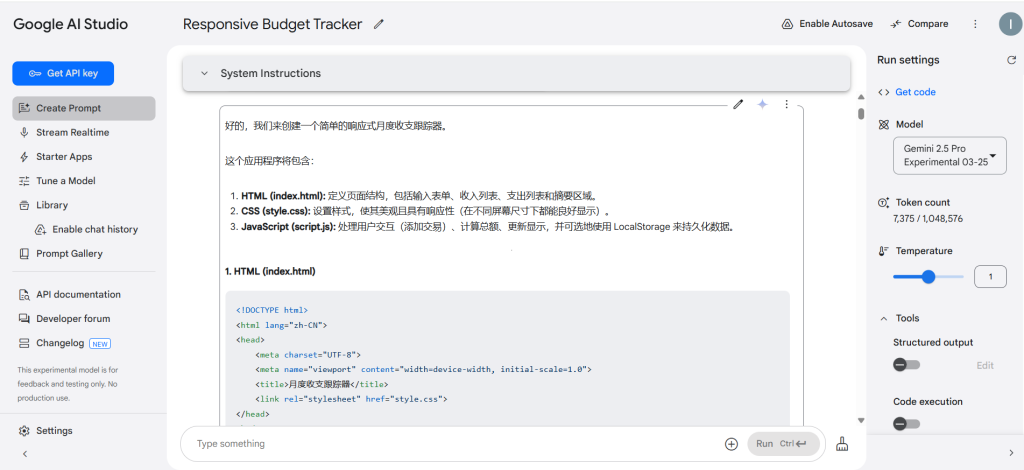
将此模型输出的三个文件放入Vs Code,注意三个文件要在同一个文件下。

完成后我们打开HTML文件可以看到
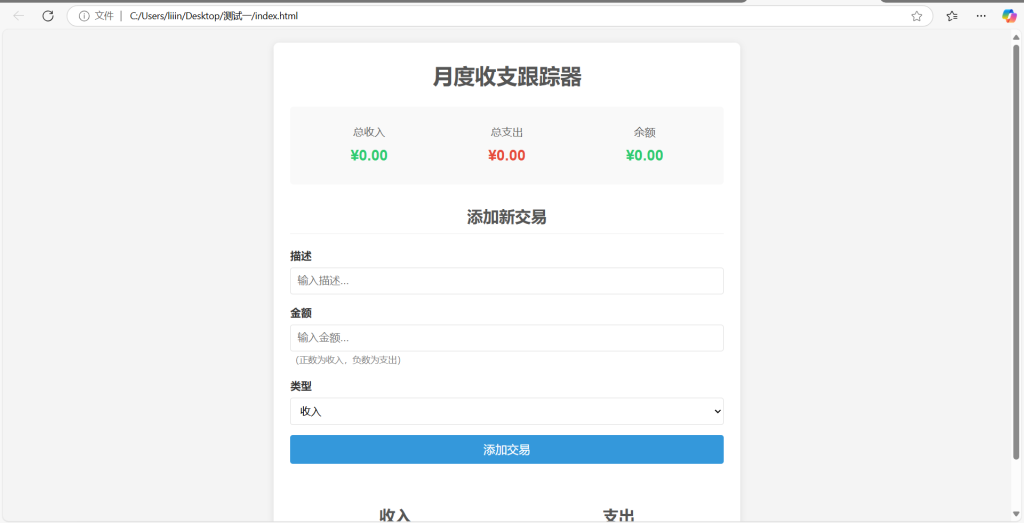
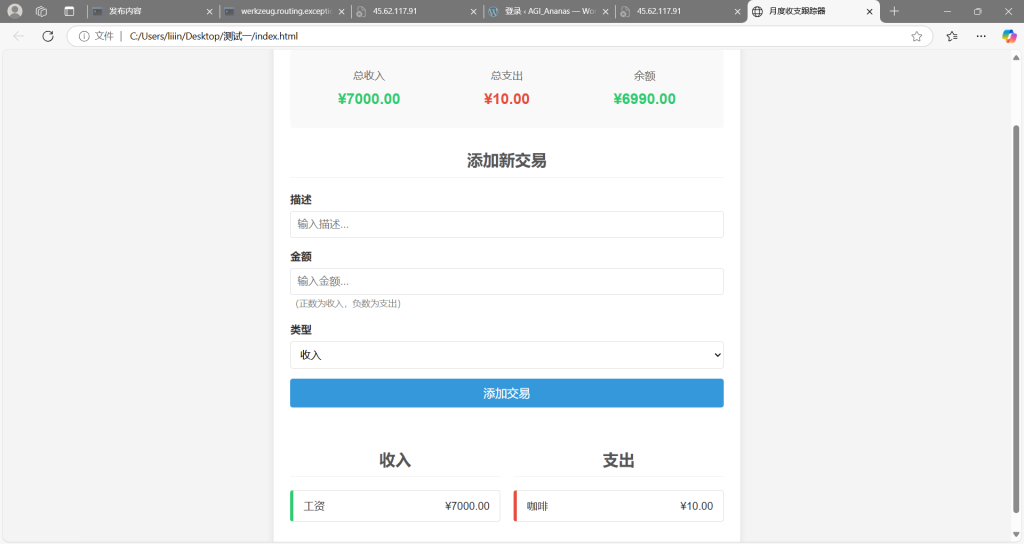
操作结果:操作通过。用户可以自由添加支出收入金额,添加相应描述,同时系统会统计总支出,总收入和余额。
测试二:创建一个生命游戏(Conway The Game Of Life)(评估模型的逻辑能力)
康威生命游戏是什么:
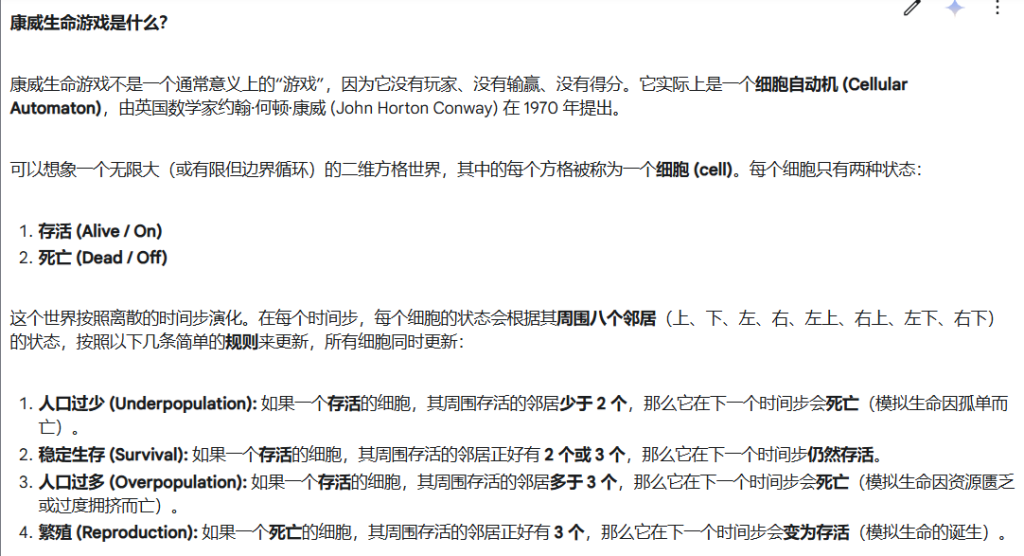
操作过程:向模型发出指令,但这次我们选择在python脚本中运行。
操作结果:测试通过,生成康威生命游戏
测试三:发送一个任何模型都难以解决的问题——利用SVG语法创建一个对称翅膀和简单造型的蝴蝶。(评估模型输出SVG代码的能力)
操作过程:向模型发出指令,并将SVG 代码输入在线工具中来查看。
操作结果:测试通过,利用svg语法生成蝴蝶。
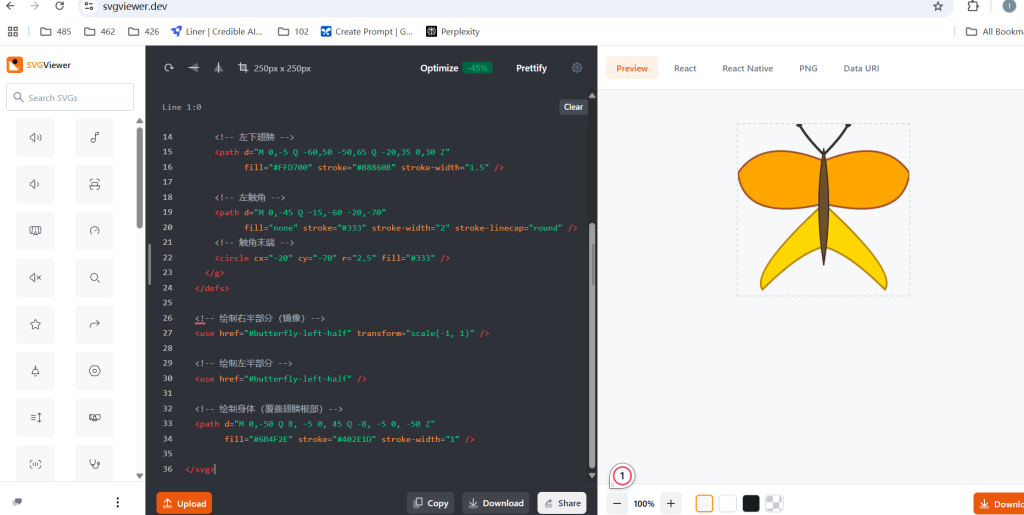
测试四:一个农民有一块三角形的天地,它的边不同,有三种不同的长度。13米,14米,15米。他想用一条通过其中一个顶点的线将它分成两个面积相等的区域,求出分界线的长度。(测试数学几何)
测试结果:通过。
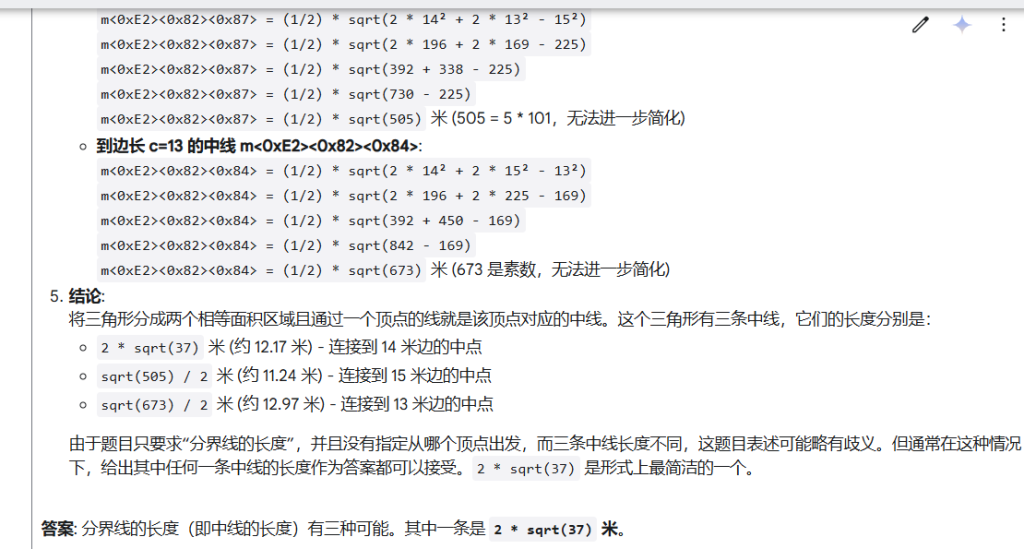
测试五:一列火车在早上8点从A市出发以每小时70公里的恒定速度驶向500公里外的B市,火车B于上午9点从B市出发以每小时80公里的恒定速度驶向A市,火车A 在出发两小时后每隔15分钟停靠一次,火车B不间断行驶。两列火车在什么时间相遇?火车在离A市多远的地方实际相遇?(测试模型的代数和速率)
测试结果:通过。
模型进行了这几个步骤:分析初始阶段 (8:00 AM – 9:00 AM)——分析第二阶段 (9:00 AM – 10:00 AM)——分析第三阶段 (10:00 AM 之后)——计算相遇时间——计算相遇地点 (距离A市)
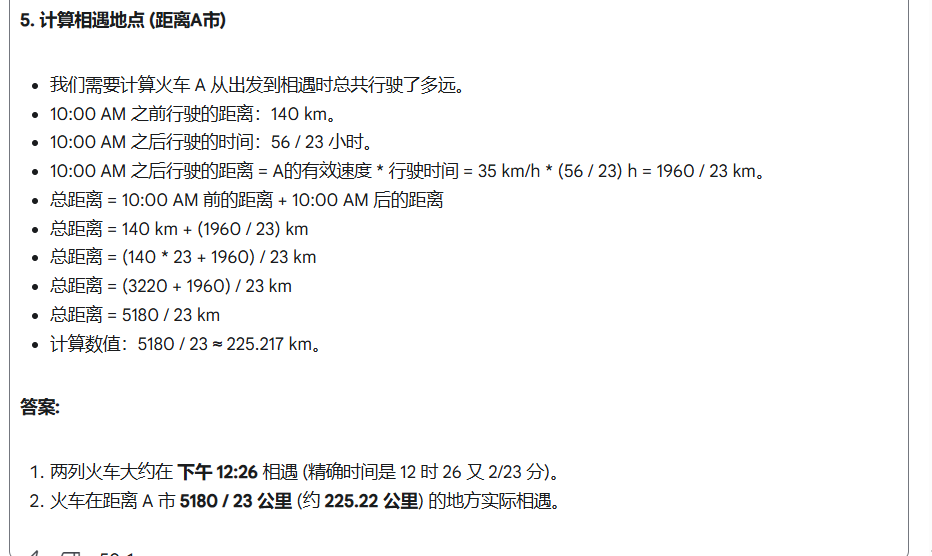
测试六:识别修复pythonPython 函数中的逻辑错误和潜在的运行时错误。该函数旨在返回所有正数的乘积。如果列表不包含正数,则应返回 1。该函数还应通过忽略非数字类型的列表来妥善处理它们。(三处错误)
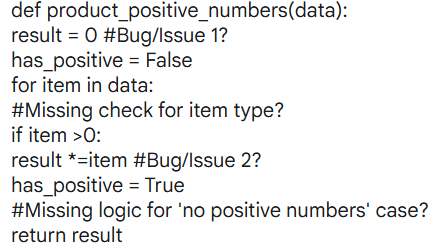
测试结果:通过
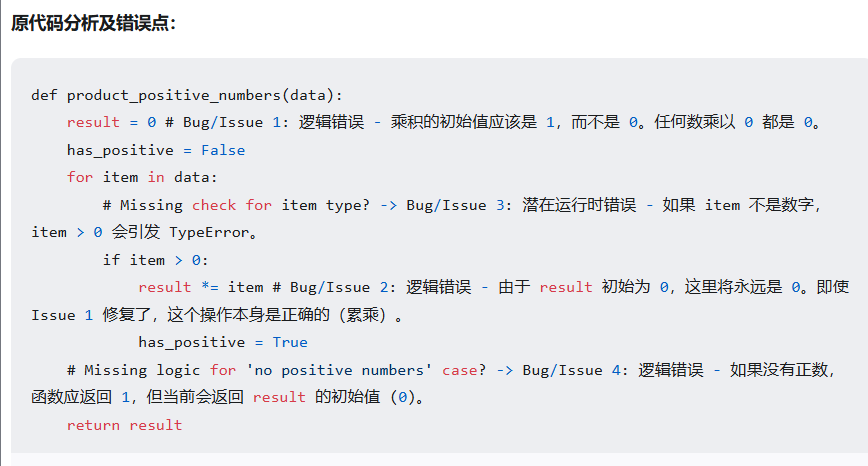
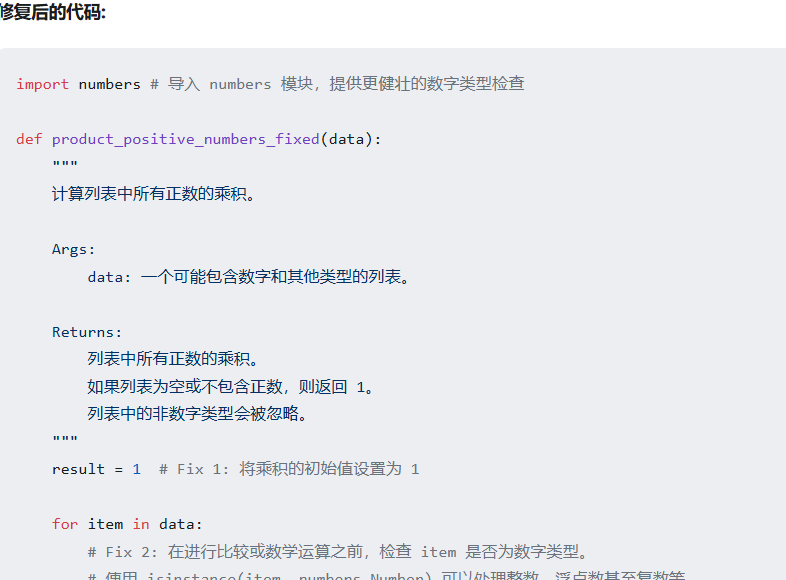
测试七:图书馆需要购买总计正好 250 美元的教学材料。他们可以以每本 12 美元的价格购买练习册,以每本 35 美元的价格购买教育应用程序许可证,以每本 55 美元的价格购买科学套件。他们必须购买每种类型的物品中的至少一个。找出满足这些条件的所有可能组合(练习册、应用程序、套件的数量)。(测试离散数学中的数论,线性方程)
测试结果:通过
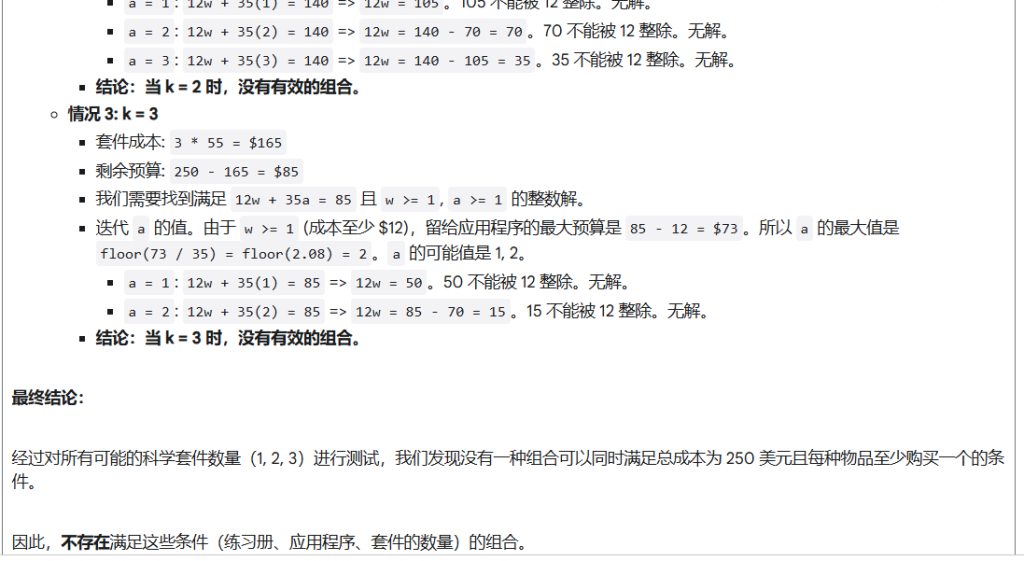
测试八:一个城镇有两种人:说真话的人(总是说真话)和撒谎的人(总是撒谎)。你遇到了三个人:A、B 和 C。A 说:“B 是个撒谎者。”B 说:“C 是个说真话的人。”C 说:“A 和 B 属于不同类型。”确定谁是说真话的人,谁是撒谎者,并逐步解释你的推理(测试模型逻辑)
测试结果:
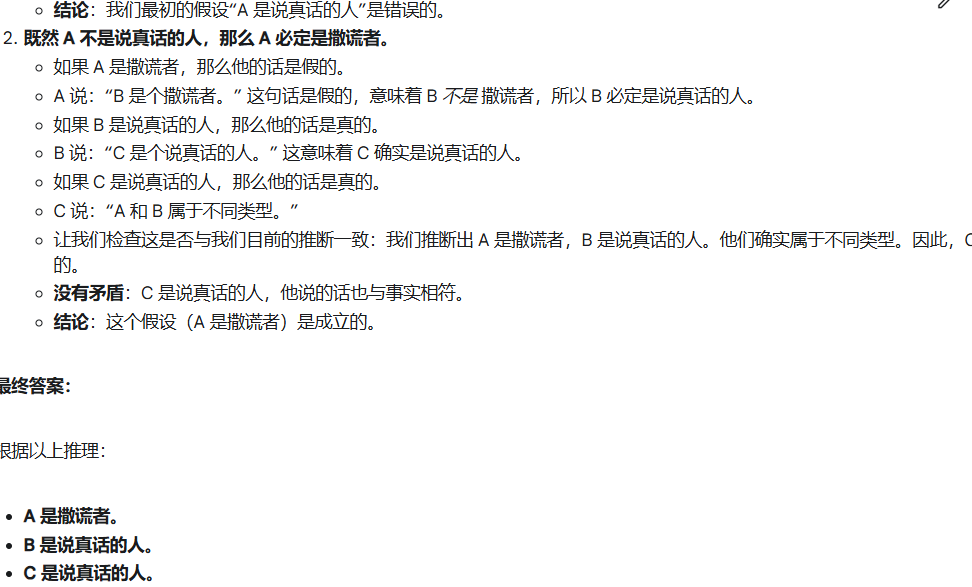
关于测试八Gemini 2.5和DeepseekV3的对比
操作过程:使用OpenRouter同时选择这两个模型并提问测试八的问题
操作结果:内容一致,Gemini2.5速度更快。
下一步操作,在更多测试内容上通过结果和速度将Gemini2.5与其它模型做对比。
OpenAI Agents SDK 分析
核心概念
- 智能体(Agents):配置了指令、工具、防护栏和移交功能的LLM
- 移交(Handoffs):允许智能体将控制权转移给其他智能体来处理特定任务
- 防护栏(Guardrails):可配置的输入/输出验证安全检查
- 追踪(Tracing):内置的智能体运行跟踪,用于调试和优化
安装
git clone https://github.com/openai/openai-agents-python.git
cd openai-agents-python设置Python环境:
python -m venv env
source env/bin/activate # Linux/Mac
# 或者在Windows上:
# env\Scripts\activate安装SDK:
pip install openai-agents设置API密钥:
# Linux/Mac
export OPENAI_API_KEY=你的密钥
# Windows
# set OPENAI_API_KEY=你的密钥运行示例:
# 例如,运行hello world示例
cd examples/basic
python hello_world.py实例分析:
- agent_patterns文件夹
agents_as_tools.py:
- 展示了”代理即工具”模式
- 前线代理(orchestrator_agent)接收用户消息,然后从一组翻译代理中选择合适的工具
- 包含西班牙语、法语和意大利语翻译代理
- 最后使用合成代理检查翻译并产生最终响应
deterministic.py:
- 展示了确定性流程,每个步骤由特定代理执行
- 流程:生成故事大纲 → 检查大纲质量和类型 → 如果符合条件则创作故事
- 包含质量门控检查,如果大纲不是高质量或不是科幻故事则终止流程
input_guardrails.py:
- 展示了如何使用输入防护机制
- 防护机制在代理执行的同时并行运行
- 实现了一个检测用户是否请求解决数学作业的防护措施
- 如果防护触发,会用拒绝消息响应而不是正常处理请求
llm_as_a_judge.py:
- 展示了”LLM作为评判者”模式
- 第一个代理生成故事大纲,第二个代理评判并提供反馈
- 循环迭代直到评判代理对大纲满意为止
- 强制要求至少一次修改(”第一次尝试永远不给通过”)
output_guardrails.py:
- 展示了如何使用输出防护机制
- 检查代理输出是否包含敏感数据(这里是电话号码)
- 如果检测到敏感数据,防护措施会触发
parallelization.py:
- 展示了并行化模式
- 并行运行同一代理三次,产生三个不同的翻译结果
- 然后使用选择代理挑选最佳翻译
routing.py:
- 展示了交接/路由模式
- 分流代理接收第一条消息,然后根据请求的语言交给合适的代理
- 支持法语、西班牙语和英语代理
- 响应实时流式传输给用户
hello_world.py
这是最基本的例子,展示了如何创建一个简单的代理并运行它:
- 创建一个只用海口(haiku)回答的代理
- 使用
Runner.run()执行代理 - 获取最终输出结果
dynamic_system_prompt.py
展示了如何基于上下文动态设置代理的指令:
- 创建自定义上下文类(
CustomContext),包含代理的风格 - 定义动态指令函数,根据风格返回不同的指令
- 随机选择风格(海口、海盗或机器人)并运行代理
agent_lifecycle_example.py 和 lifecycle_example.py
这两个文件展示了代理生命周期的监控:
- 定义自定义钩子类来监控代理的各种事件
- 使用工具(如
random_number和multiply_by_two) - 设置代理之间的交接逻辑(如果数字为奇数则交给乘法代理)
- 监控和输出代理执行的完整生命周期
区别在于 agent_lifecycle_example.py 使用 AgentHooks 绑定到特定代理,而 lifecycle_example.py 使用 RunHooks 绑定到整个运行过程。
stream_items.py 和 stream_text.py
展示了框架的流式输出功能:
stream_items.py展示如何处理各种流式事件(工具调用、工具输出、消息输出等)stream_text.py展示如何直接流式输出文本内容
计算机控制:通过 ComputerTool 和 AsyncComputer 接口,代理可以直接控制浏览器执行复杂的网页操作任务,这对于自动化网络交互、数据收集和UI测试非常有用。
向量搜索:通过 FileSearchTool,代理可以搜索预先准备的向量数据库,适用于文档检索、知识库问答等场景。
网络搜索:通过 WebSearchTool,代理可以直接搜索互联网获取实时信息,适合需要最新数据的场景。
演示
research_bot
web_search.py
Archon: AI代理构建AI!
Archon是一个创新的AI元代理系统,其核心理念是通过抓取各种框架的文档,来构建能够使用这些框架的AI代理。作为世界上第一个”Agenteer”(代理工程师),它能够自主构建、改进和优化其他AI代理。
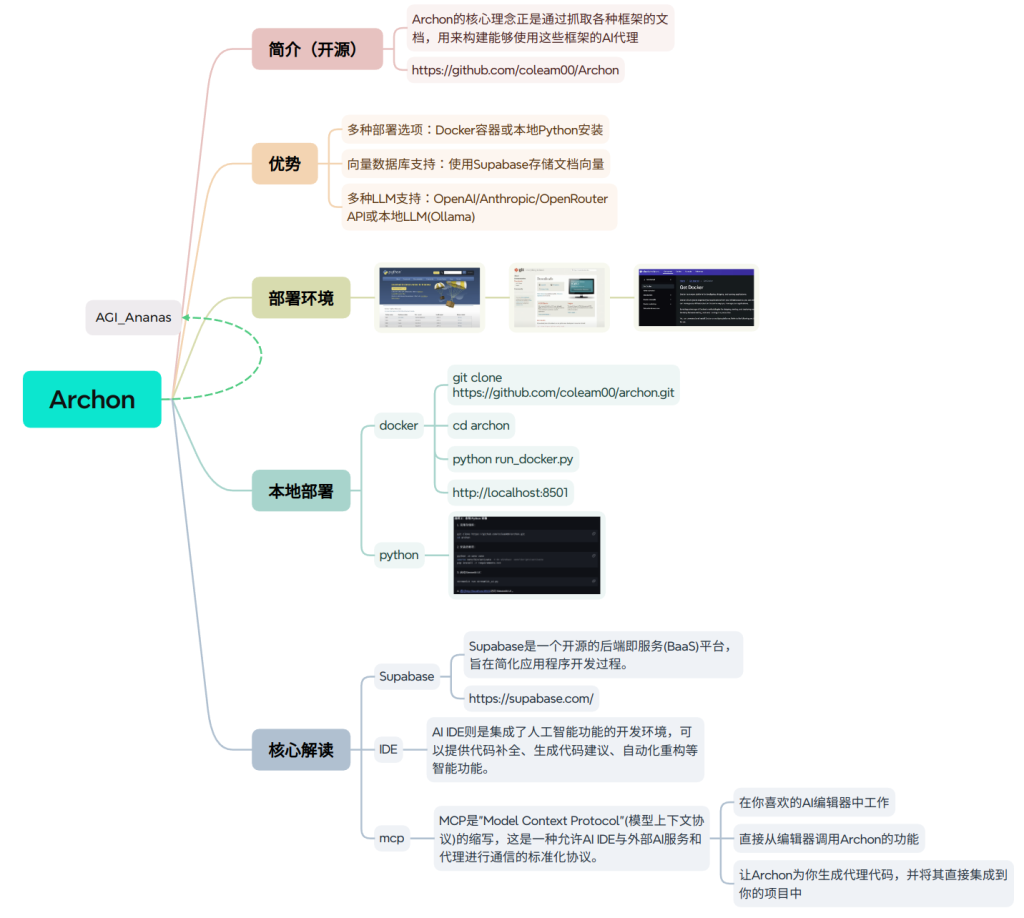
Archon的核心是通过抓取各种框架的文档,用来构建能够使用这些框架的AI代理。
优势
- 多种部署选项:Docker容器或本地Python安装
- 向量数据库支持:使用Supabase存储文档向量
- 多种LLM支持:OpenAI/Anthropic/OpenRouter API或本地LLM(Ollama)
核心解读:Supabase
Supabase是一个开源的后端即服务(BaaS)平台,旨在简化应用程序开发过程。在Archon中,它主要用于存储和检索向量化的框架文档,为代理提供知识基础。
本地部署
Docker方式
git clone https://github.com/coleam00/archon.git
cd archon
python run_docker.py部署完成后访问 http://localhost:8501
Python方式
git clone https://github.com/coleam00/archon.git
cd archon
python -m venv venv
source venv/bin/activate # Windows: venv\Scripts\activate
pip install -r requirements.txt
streamlit run streamlit_ui.py核心解读:IDE
AI IDE是集成了人工智能功能的开发环境,比如Windsurf、Cursor和Cline,可以提供代码补全、生成代码建议等智能功能。
部署环境
完成安装后,需要在Streamlit UI配置以下环境:
- 环境配置:设置API密钥和模型选择
- 数据库设置:配置Supabase向量数据库
- 文档抓取:爬取Pydantic AI文档,建立知识库
- 代理服务:启动生成代理的服务
核心解读:MCP
MCP是”Model Context Protocol”(模型上下文协议),这是一种允许AI IDE与外部AI服务通信的标准化协议。通过MCP配置,可以:
- 在你喜欢的AI编辑器中工作
- 直接从编辑器调用Archon功能
- 让Archon为你生成代理代码,并直接集成到项目中
使用方法
完成所有配置后,可以:
- 转到聊天选项卡
- 描述你想要构建的代理
- Archon会规划并生成必要的代码
如果配置了MCP,还可以直接在AI IDE中使用Archon的功能,让Archon为你生成代理代码,并将其集成到你的项目中。
总结
Archon通过创新的文档抓取和向量化方法,展示了元学习在AI系统构建中的潜力。它不仅是一个实用的开发工具,也是一个展示智能代理系统演化的教育框架。随着其不断迭代完善,Archon有望成为AI代理开发生态系统的重要组成部分。
DeepSeek多模态模型本地部署测试
Janus-Pro
:adoresever
显存要求:1B 识别图片:6G 生成图片9G
1.创建环境并安装基础依赖
# 创建Python环境(建议3.8以上)
conda create -n janus python=3.8
conda activate janus
# 克隆项目代码
git clone https://github.com/deepseek-ai/Janus.git
cd Janus
# 安装基础依赖
pip install -e .
# 安装Gradio界面依赖(如果需要UI界面)
pip install -e .[gradio]2.运行Demo(建议修改为1b模型)
# 启动
python demo/app_januspro.pyimport gradio as gr
import torch
from transformers import AutoConfig, AutoModelForCausalLM
from janus.models import MultiModalityCausalLM, VLChatProcessor
from janus.utils.io import load_pil_images
from PIL import Image
import numpy as np
import os
# import spaces # Import spaces for ZeroGPU compatibility
# Load model and processor
model_path = "deepseek-ai/Janus-Pro-1B"
config = AutoConfig.from_pretrained(model_path)
language_config = config.language_config
language_config._attn_implementation = 'eager'
vl_gpt = AutoModelForCausalLM.from_pretrained(model_path,
language_config=language_config,
trust_remote_code=True)
if torch.cuda.is_available():
vl_gpt = vl_gpt.to(torch.bfloat16).cuda()
else:
vl_gpt = vl_gpt.to(torch.float16)
vl_chat_processor = VLChatProcessor.from_pretrained(model_path)
tokenizer = vl_chat_processor.tokenizer
cuda_device = 'cuda' if torch.cuda.is_available() else 'cpu'
@torch.inference_mode()
# @spaces.GPU(duration=120)
# Multimodal Understanding function
def multimodal_understanding(image, question, seed, top_p, temperature):
# Clear CUDA cache before generating
torch.cuda.empty_cache()
# set seed
torch.manual_seed(seed)
np.random.seed(seed)
torch.cuda.manual_seed(seed)
conversation = [
{
"role": "<|User|>",
"content": f"<image_placeholder>\n{question}",
"images": [image],
},
{"role": "<|Assistant|>", "content": ""},
]
pil_images = [Image.fromarray(image)]
prepare_inputs = vl_chat_processor(
conversations=conversation, images=pil_images, force_batchify=True
).to(cuda_device, dtype=torch.bfloat16 if torch.cuda.is_available() else torch.float16)
inputs_embeds = vl_gpt.prepare_inputs_embeds(**prepare_inputs)
outputs = vl_gpt.language_model.generate(
inputs_embeds=inputs_embeds,
attention_mask=prepare_inputs.attention_mask,
pad_token_id=tokenizer.eos_token_id,
bos_token_id=tokenizer.bos_token_id,
eos_token_id=tokenizer.eos_token_id,
max_new_tokens=512,
do_sample=False if temperature == 0 else True,
use_cache=True,
temperature=temperature,
top_p=top_p,
)
answer = tokenizer.decode(outputs[0].cpu().tolist(), skip_special_tokens=True)
return answer
def generate(input_ids,
width,
height,
temperature: float = 1,
parallel_size: int = 5,
cfg_weight: float = 5,
image_token_num_per_image: int = 576,
patch_size: int = 16):
# Clear CUDA cache before generating
torch.cuda.empty_cache()
tokens = torch.zeros((parallel_size * 2, len(input_ids)), dtype=torch.int).to(cuda_device)
for i in range(parallel_size * 2):
tokens[i, :] = input_ids
if i % 2 != 0:
tokens[i, 1:-1] = vl_chat_processor.pad_id
inputs_embeds = vl_gpt.language_model.get_input_embeddings()(tokens)
generated_tokens = torch.zeros((parallel_size, image_token_num_per_image), dtype=torch.int).to(cuda_device)
pkv = None
for i in range(image_token_num_per_image):
with torch.no_grad():
outputs = vl_gpt.language_model.model(inputs_embeds=inputs_embeds,
use_cache=True,
past_key_values=pkv)
pkv = outputs.past_key_values
hidden_states = outputs.last_hidden_state
logits = vl_gpt.gen_head(hidden_states[:, -1, :])
logit_cond = logits[0::2, :]
logit_uncond = logits[1::2, :]
logits = logit_uncond + cfg_weight * (logit_cond - logit_uncond)
probs = torch.softmax(logits / temperature, dim=-1)
next_token = torch.multinomial(probs, num_samples=1)
generated_tokens[:, i] = next_token.squeeze(dim=-1)
next_token = torch.cat([next_token.unsqueeze(dim=1), next_token.unsqueeze(dim=1)], dim=1).view(-1)
img_embeds = vl_gpt.prepare_gen_img_embeds(next_token)
inputs_embeds = img_embeds.unsqueeze(dim=1)
patches = vl_gpt.gen_vision_model.decode_code(generated_tokens.to(dtype=torch.int),
shape=[parallel_size, 8, width // patch_size, height // patch_size])
return generated_tokens.to(dtype=torch.int), patches
def unpack(dec, width, height, parallel_size=5):
dec = dec.to(torch.float32).cpu().numpy().transpose(0, 2, 3, 1)
dec = np.clip((dec + 1) / 2 * 255, 0, 255)
visual_img = np.zeros((parallel_size, width, height, 3), dtype=np.uint8)
visual_img[:, :, :] = dec
return visual_img
@torch.inference_mode()
# @spaces.GPU(duration=120) # Specify a duration to avoid timeout
def generate_image(prompt,
seed=None,
guidance=5,
t2i_temperature=1.0):
# Clear CUDA cache and avoid tracking gradients
torch.cuda.empty_cache()
# Set the seed for reproducible results
if seed is not None:
torch.manual_seed(seed)
torch.cuda.manual_seed(seed)
np.random.seed(seed)
width = 384
height = 384
parallel_size = 5
with torch.no_grad():
messages = [{'role': '<|User|>', 'content': prompt},
{'role': '<|Assistant|>', 'content': ''}]
text = vl_chat_processor.apply_sft_template_for_multi_turn_prompts(conversations=messages,
sft_format=vl_chat_processor.sft_format,
system_prompt='')
text = text + vl_chat_processor.image_start_tag
input_ids = torch.LongTensor(tokenizer.encode(text))
output, patches = generate(input_ids,
width // 16 * 16,
height // 16 * 16,
cfg_weight=guidance,
parallel_size=parallel_size,
temperature=t2i_temperature)
images = unpack(patches,
width // 16 * 16,
height // 16 * 16,
parallel_size=parallel_size)
return [Image.fromarray(images[i]).resize((768, 768), Image.LANCZOS) for i in range(parallel_size)]
# Gradio interface
with gr.Blocks() as demo:
gr.Markdown(value="# Multimodal Understanding")
with gr.Row():
image_input = gr.Image()
with gr.Column():
question_input = gr.Textbox(label="Question")
und_seed_input = gr.Number(label="Seed", precision=0, value=42)
top_p = gr.Slider(minimum=0, maximum=1, value=0.95, step=0.05, label="top_p")
temperature = gr.Slider(minimum=0, maximum=1, value=0.1, step=0.05, label="temperature")
understanding_button = gr.Button("Chat")
understanding_output = gr.Textbox(label="Response")
examples_inpainting = gr.Examples(
label="Multimodal Understanding examples",
examples=[
[
"explain this meme",
"images/doge.png",
],
[
"Convert the formula into latex code.",
"images/equation.png",
],
],
inputs=[question_input, image_input],
)
gr.Markdown(value="# Text-to-Image Generation")
with gr.Row():
cfg_weight_input = gr.Slider(minimum=1, maximum=10, value=5, step=0.5, label="CFG Weight")
t2i_temperature = gr.Slider(minimum=0, maximum=1, value=1.0, step=0.05, label="temperature")
prompt_input = gr.Textbox(label="Prompt. (Prompt in more detail can help produce better images!)")
seed_input = gr.Number(label="Seed (Optional)", precision=0, value=12345)
generation_button = gr.Button("Generate Images")
image_output = gr.Gallery(label="Generated Images", columns=2, rows=2, height=900)
examples_t2i = gr.Examples(
label="Text to image generation examples.",
examples=[
"Master shifu racoon wearing drip attire as a street gangster.",
"The face of a beautiful girl",
"Astronaut in a jungle, cold color palette, muted colors, detailed, 8k",
"A glass of red wine on a reflective surface.",
"A cute and adorable baby fox with big brown eyes, autumn leaves in the background enchanting,immortal,fluffy, shiny mane,Petals,fairyism,unreal engine 5 and Octane Render,highly detailed, photorealistic, cinematic, natural colors.",
"The image features an intricately designed eye set against a circular backdrop adorned with ornate swirl patterns that evoke both realism and surrealism. At the center of attention is a strikingly vivid blue iris surrounded by delicate veins radiating outward from the pupil to create depth and intensity. The eyelashes are long and dark, casting subtle shadows on the skin around them which appears smooth yet slightly textured as if aged or weathered over time.\n\nAbove the eye, there's a stone-like structure resembling part of classical architecture, adding layers of mystery and timeless elegance to the composition. This architectural element contrasts sharply but harmoniously with the organic curves surrounding it. Below the eye lies another decorative motif reminiscent of baroque artistry, further enhancing the overall sense of eternity encapsulated within each meticulously crafted detail. \n\nOverall, the atmosphere exudes a mysterious aura intertwined seamlessly with elements suggesting timelessness, achieved through the juxtaposition of realistic textures and surreal artistic flourishes. Each component\u2014from the intricate designs framing the eye to the ancient-looking stone piece above\u2014contributes uniquely towards creating a visually captivating tableau imbued with enigmatic allure.",
],
inputs=prompt_input,
)
understanding_button.click(
multimodal_understanding,
inputs=[image_input, question_input, und_seed_input, top_p, temperature],
outputs=understanding_output
)
generation_button.click(
fn=generate_image,
inputs=[prompt_input, seed_input, cfg_weight_input, t2i_temperature],
outputs=image_output
)
demo.launch(share=True)
# demo.queue(concurrency_count=1, max_size=10).launch(server_name="0.0.0.0", server_port=37906, root_path="/path")